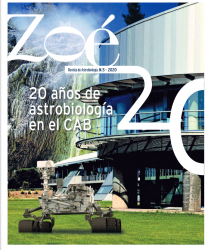On 19 November 2019 we celebrated the twentieth anniversary of the establishment of the Centro de Astrobiología (CAB) as a joint centre of the National Institute of Aerospace Technology (INTA) and the Spanish National Research Council (CSIC). CAB was created to generate synergies between two public research organisations, leaders in aerospace technology and research, in order to address fundamental issues in Astrobiology. The hard work and magnitude of the successful projects of the last 20 years at CAB have made it possible for us to actively participate in major international space projects and missions. The scope and diversity of our achievements have been recognised by the Ministry of Science and Innovation with the “María de Maeztu” Scientific Excellence award through the project “Evaluating the emergence of life as a universal phenomenon through planetary exploration”. This project allows us to reinforce and strengthen the interactions between the current research lines in the Centre and, at the same time, promote the growth of new research areas that will become new transdisciplinary and high-impact projects.
The next decade brings new challenges and opportunities for the Centro de Astrobiología.CAB scientists will have an unprecedented opportunity to study the atmosphere of Mars simultaneously with three independent environmental stations that were built and are/will be operating under its leadership (REMS, TWINS and MEDA). They will also contribute to the science and operation of the Raman Laser Spectrometer (RLS) that will fly on ESA’s ExoMars mission after its launch in 2022. Our participation in Mars 2020 (MEDA) together with our powerful analytical capabilities on the ground, for biomarker detection and identification, puts us in a unique position to participate in the Mars Sample Return mission.
The arrival of more precise and sophisticated instrumentation will open up new avenues for space research in which CAB scientists are actively participating. Particularly relevant will be the PLATO (ESA) space telescopes, which will search for and characterise Earth-like planets and their atmospheres; and JWST (NASA, ESA, CSA) which will study the dust clouds where stars and planetary systems are forming; or Harmoni (ESA) an optical and near-infrared spectrograph on the Extremely Large Telescope (ELT, Chile), which will complement ALMA and JWST in the study of galaxies in the early universe and the detailed characterisation of exoplanets, among other studies.
Understanding the potentially habitable environments of the thousands of planets yet to be discovered, along with the remote identification of potential biomarkers, requires simulation and research in analogous environments and processes on Earth to improve our understanding of how life can exist and interact in both surface and shallow and deep subsurface environments. CAB has the means, the facilities, and the right people to address and contribute to the elucidation of the main Astrobiology challenges in the near future, which will undoubtedly provide another 20 years of success.
Victor Parro García – Director of Centro de Astrobiología







